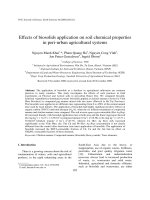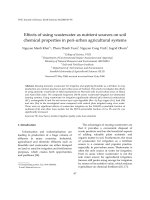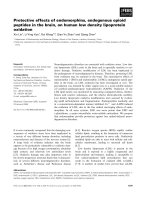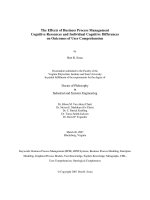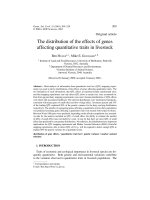Effects of preceding scented rice varieties in combination with organic inputs on soil microbial properties in scented rice (Oryza sativa)-Lathyrus (Lathyrus sativus L.) relay cropping
Bạn đang xem bản rút gọn của tài liệu. Xem và tải ngay bản đầy đủ của tài liệu tại đây (170.74 KB, 5 trang )
Int.J.Curr.Microbiol.App.Sci (2019) 8(4): 2085-2089
International Journal of Current Microbiology and Applied Sciences
ISSN: 2319-7706 Volume 8 Number 04 (2019)
Journal homepage:
Original Research Article
/>
Effects of Preceding Scented Rice Varieties in Combination with Organic
Inputs on Soil Microbial Properties in Scented Rice (Oryza sativa)-Lathyrus
(Lathyrus sativus L.) Relay Cropping under Organic System
Chayanika Borah*, Jogesh Goswami, Khogen Kurmi and Gauri Mohan
Department of Agronomy, Assam Agricultural University, Jorhat-13, India
*Corresponding author
ABSTRACT
Keywords
Scented rice, Relay
lathyrus, Soil
microbial properties
Article Info
Accepted:
15 March 2019
Available Online:
10 April 2019
A field experiment was conducted during Kharif and Rabi seasons 2016-17 to evaluate the
effects of preceding scented rice varieties and carry-over nutrients on soil microbial
properties (microbial biomass carbon, microbial population and dehydrogenase activity) in
scented rice-lathyrus relay cropping under organic system. The nine treatments included
three scented rice varieties and five organic inputs and one control which were laid out in
factorial RBD with 3 replications. Among the three preceding scented rice varieties, the
highest microbial biomass carbon (912.91µg TPF/g/day) and dehydrogenase activity
(58.11μg TPF/g/day) was found in CR-Dhan-909 and the highest microbial population was
found in kola joha [soil bacteria (37.81log cfu/g) and fungi (4.32log cfu/g)]. In case of
carry-over nutrients, enriched compost recorded highest microbial biomass carbon
(935.24µg TPF/g/day), dehydrogenase activity (60.96μg TPF/g/day), soil bacteria (4.3log
cfu/g) and fungi (4.54log cfu/g).
Introduction
Ensuring global food security with changing
environment and shrinking natural resources
are the major challenges in the present era
(Hussain et al., 2015). Sustainable use of
natural resources in the fact of high
population density is critically important and
consequently food insecurity is overwhelming
for
specially
developing
countries
(Munsinguzi et al., 2015; Nyssen et al., 2015;
Tsozue et al., 2015). The increasing
population pressure on land and water
resources leads to degradation of these
resources, which often results in loss of
productive capacity and food insecurity as a
consequence of soil degradation and the
increase on soil erosion (Borrelli et al., 2015;
Gessesse et al., 2015). This situation has led
to the excessive exploitation of natural
resources and increased soil losses (Novara et
al., 2015).
Relay cropping is a sustainable approach that
optimizes
system
productivity
and
compensates yield of two crops at a time and
can solve time contravene among sowing of
different crops. It possesses the capability to
2085
Int.J.Curr.Microbiol.App.Sci (2019) 8(4): 2085-2089
improve soil quality, to increase net return
and land equivalent ratio and to control weed
and pest infestation, thereby decreasing
chemical pest control measures (Jabbar et al.,
2011; Bandyopadhyay et al., 2016).
The fertility building in organic cropping
system has consequences for soil biological
properties (Robertson et al., 2000; Madar et
al., 2002) and changes in organic inputs may
affect crop yield and soil properties
differently in different system depending on
mineral nutrient supply to the crops. Hence,
the present study was planned to evaluate
effects of preceding scented rice varieties and
carry-over nutrients on soil microbial
properties (microbial biomass carbon,
microbial population and dehydrogenase
activity)in scented rice-lathyrus relay
cropping under organic system.
Vermicompost (I3), Green leaf manuring (I4)
and Azolla compost (I5) as 100% RDN and
microbial consortium(I6) @ 3.5-4 kg/ha.
Organically grown lathyrus (Variety Ratan)
seeds were soaked in water the day before
sowing and seeds were sown broadcasted
@45kg seeds/ha in the standing rice crop. An
overlapping period of 10 days was observed
in CR Dhan-909 and 18 days was observed in
Badshahbhog and Kola joha respectively.
Organic manures were applied in standing
rice crop and after harvest of rice soil
microbial properties were recorded as MBC
(934.99µg/g dry soil), DHA (60.57μg
TPF/g/day) and Microbial population (43.66
and 3.87log cfu/g soil for bacteria & fungi
respectively). The experiment was laid out in
factorial randomized block design with three
replications.
Results and Discussion
Materials and Methods
The experiment was carried out at the
Instructional-cum-research Farm, Assam
agricultural University, Jorhat during kharif
and rabi seasons, 2016-17. The experiment
site was under five years of conversion period
and behaved like organic ecosystem which
justifies the credibility of organic practices
followed. The organic inputs under study
were also produced under strict organic
guidelines of Assam Agricultural University.
The plant protection measures and seeds
collected for experiment were governed under
organic guidelines.
Thus the control plot with no external organic
inputs may be treated as organic with native
fertility and biological makeup. The soil of
the experimental field was acidic in reaction
(pH 5.26). The experiment had eighteen
treatment combinations viz., scented rice
varieties were Badshahbhog (V1), CR dhan909(V2) and Kolajoha (V3) and organic inputs
were Control (I1), Enriched compost (I2),
Though no significant effect was found in
case of MBC from preceding rice varieties
and carry-over nutrients, in case of carry-over
nutrients highest MBC was found in enriched
compost (935.24µg TPF/g/day)and lowest in
control (885.69 µg TPF/g/day)and in
preceding scented rice varieties, highest
MBCwas recordedin CR Dhan-909(912.91 µg
TPF/g/day)and lowest in Badshahbhog
(891.91 µg TPF/g/day) when evaluated after
harvest of relay lathyrus (Table 1).
Effects of carry-over nutrients for DH activity
were found to increase over control.
Significantly higher DH was recorded with
application of enriched compost (60.96μg
TPF/g/day), which was at par with azolla
compost (58.90μg TPF/g/day), microbial
consortium (60.25μg TPF/g/day), green leaf
manuring
(59.99μg
TPF/g/day)
and
vermicompost (57.4182μg TPF/g/day). The
lowest DH (50.82μg TPF/g/day) was recorded
in the control. No significant difference was
found in case of variety (Table 1).
2086
Int.J.Curr.Microbiol.App.Sci (2019) 8(4): 2085-2089
It was observed that within the interaction
effects, DH activity in Badshahbhog growing
plots was found highest in green leaf
manuring (63.74μg TPF/g/day)which was at
par with all the other tested treatments except
control. Similarly, CRDhan-909 growing
plots with enriched compost recorded highest
interaction (60.96μg TPF/g/day) which was at
par with all the other treatments and Kolajoha
growing plots with enriched compost
(62.09μg
TPF/g/day)
and
microbial
consortium (62.09μg TPF/g/day) was
recorded highest interaction in terms of DH
activity which was at par with vermicompost,
green leaf manure and azolla compost (Table
1a). Residual effect of carry-over nutrients
from applied organic inputs on soil bacteria
was found significant. Highest was found in
enriched compost (43.61 log cfu/g) which was
at par with green leaf manuring (42.30 log
cfu/g) and lowest was obtained in control
(26.93log cfu/g). Residual effect on bacterial
population on plots where different varieties
were grown found non-significant. Highest
was found in kola joha (37.81log cfu/g) and
lowest on CR Dhan-909 (32.27log
cfu/g).Residual effect of organic input, variety
as well as interaction effect on fungal
population was found non-significant. Highest
value under organic input was recorded in
enriched compost (4.54log cfu/g) and lowest
was found in control (4.05log cfu/g). Among
varieties highest was found in kola joha
(4.32log cfu/g) and lowest in CR Dhan-909
(4.17log cfu/g) (Table 1).
Table.1 Effect of preceding rice varieties and carry-over nutrients from organic inputs on soil
biological properties after harvest of lathyrus
Treatment
Varieties
V1: Badshahbhog
V2: CR Dhan-909
V3: Kola joha
SEd(±)
CD(P=0.05)
Organic inputs
I1: Control
I2: Enriched compost
I3: Vermicompost
I4 :
Green
leaf
manuring
I5: Azolla compost
I6 :
Microbial
consortium
SEd(±)
CD (P=0.05)
(V×I )
Dehydrogenase
activity(µg/g dry
soil)
Microbial
biomass
carbon
(µg
TPF/g/day)
58.09
58.11
57.97
1.61
NS
891.91
912.91
903.26
17.68
NS
36.07
32.27
37.81
2.27
NS
4.23
4.17
4.32
0.19
NS
50.82
60.96
57.41
59.99
885.69
935.24
886.19
893.67
26.93
43.61
38.42
42.30
4.05
4.54
4.20
4.08
58.90
60.25
900.79
914.55
29.37
31.69
4.11
4.46
2.28
4.64
NS
25.00
NS
NS
3.21
4.61
NS
0.27
NS
NS
2087
Microbial
population(log cfu/g)
Bacteria
Fungi
Int.J.Curr.Microbiol.App.Sci (2019) 8(4): 2085-2089
Table.1a Interaction effect of preceding rice varieties and carry-over nutrients on dehydrogenase
activity
Treatments
I1: Control
I2: Enriched compost
I3: Vermicompost
I4: Green leaf manuring
I5: Azolla compost
I6: Microbial consortium
SEd(±)
CD (P=0.05)
Badshahbhog (V1)
48.73
59.82
59.33
63.74
55.01
61.93
CR Dhan-909 (V2)
53.21
60.96
59.07
58.20
60.46
56.74
3.95
8.04
Kola joha(V3)
50.53
62.09
53.84
58.03
61.23
62.09
Table.1b Interaction effect of preceding rice varieties and carry-over nutrients on bacterial
population of soil
Treatments
I1: Control
I2: Enriched compost
I3: Vermicompost
I4: Green leaf manuring
I5: Azolla compost
I6: Microbial consortium
SEd(±)
CD (P=0.05)
Badshahbhog (V1)
23.73
46.75
45.23
46.22
23.91
30.61
Badshahbhog growing plots with enriched
compost reported maximum interaction effect
on bacterial population (46.75 log cfu/g) which
was at par with vermicompost and green leaf
manuring. Similarly, CRDhan-909 growing
plots with enriched compostrecorded highest
interaction(37.46 log cfu/g) which was at par
with all the other tested treatments except
control and Kolajoha with green leaf manure
interaction recorded highest on bacterial
population (49.84 log cfu/g) which was at par
with enriched compost (Table 1b). Similar
observations on soil microbial properties were
observed by Padmanabhan et al., (2014), Yadav
et al., (2013) and Singh and Dhar (2011), who
reported continuous enhancement in microbial
population of actinomycetes, bacteria, fungi and
BGA were recorded over the years due to the
application of organic amendments with notable
enhancement in dehydrogenase enzyme activity.
CR Dhan-909 (V2)
25.26
37.46
33.89
30.84
34.14
32.05
5.56
7.99
Kola joha (V3)
31.81
46.63
36.13
49.84
30.07
32.42
The enhanced microbial population upon
application of different sources of organic
matter is in close agreement with present
studies (Kannan et al., 2006; Aher et al., 2018).
With the results, it can be concluded that
maximum residual effect from carry-over
nutrients was observed in case of enriched
compost irrespective of the scented rice
varieties in scented rice – lathyrus relay
cropping under organic system.
Abbreviations: MBC: Microbial Biomass
Carbon, DHA: Dehydrogenase Activity.
References
Aher, S. B., Lakaria, B. L., Swami K., Singh, A.
B., Ramana, S., Thakur, J. K., Biswas, A.
K., Jha, P., Manna, M. C. and Yashona,
D. S. 2018. Soil microbial population and
2088
Int.J.Curr.Microbiol.App.Sci (2019) 8(4): 2085-2089
enzyme
activities
under
organic,
biodynamic and conventional agriculture
in semi-arid tropical conditions of central
India. Journal of Experimental Biology
and Agricultural Sciences. 6(5): 763-773.
Bandyopadhyay PK, Singh KC, Mondal K,
Nath R, Ghosh PK, Kumar N, Singh SS.
2016. Effects of stubble length of rice in
mitigating soil moisture stress and yield
of lentil (Lens culinaris Medik) in ricelentil relay crop. Agric Water Manag.
173: 91-102.
Borrelli P, Märker M, Schütt B. 2015.
Modelling
post-tree-harvesting
soil
erosion and sediment deposition potential
in the turano river basin (Italian central
apennine). Land Degrad Dev. 26(4): 356–
366.
Gessesse B, Bewket W, Bräuning A. 2015.
Model-based
characterization
and
monitoring of runoff and soil erosion in
response to land use/land cover changes
in the Modjo watershed, Ethiopia. Land
Degrad Dev. 26(7): 711–724.
Hussain S, Peng S, Fahad S, Khaliq A, Huang J,
Cui K, Nie L. 2015. Rice management
interventions to mitigate greenhouse gas
emissions: a review. Environ SciPollut
Res. 22: 3342-3360.
Jabbar A, Ahmad R, Bhatti IH, Aziz T, Nadeem
M, Wasi-u-Din RA. 2011. Residual soil
fertility as influenced by diverse ricebasedinter/relay cropping systems. Int J
Agric Biol. 13:477–483
Kannan, P., Saravanan, A. and Balaji, T. 2006.
Organic farming on tomato yield and
quality. Crop Res. 32(2): 196-200.
Mader P., Fliessbach, A., Dubois, D., Gunst, L.,
Fried, P., Niggli, U. 2002.Soil fertility
and biodiversity in organic farming.
Science. 296: 1694-1697.
Musinguzi P, Ebanyat P, Tenywa JS, Basamba
TA, Tenywa MM, Mubiru D. 2015.
Precision of farmer-based fertility ratings
and soil organic carbon for crop
production on a Ferralsol. Solid Earth.
6:1063–1073.
Novara A, Rühl J, La Mantia T, Gristina L, La
Bella S, Tuttolomondo T.2015. Litter
contribution to soil organic carbon in the
processes of agriculture abandon. Solid
Earth. 6(2):425
Nyssen J, Frankl A, Zenebe A, Poesen J,
Deckers
J.
2015.
Environmental
conservation for food production and
sustainable
livelihood
in
tropical
Africa.Land Degrad Dev. 26(7):629–631.
Padmanabhan, M., Hanumanthappa, M. and
Shamaraj. 2014. Effect of different
organic manures on yield, nutrient
availability and soil microflora in
transplanted rice. Bionfolet. 11(1): 222226.
Robertson, G.P., Paul, E. A. and Harwood, R.R.
2000. Greenhouse gases in intensive
agriculture; Contributions of individual
gases to the radiative forcing of the
atmosphere. Science. 289: 1922-1925.
Singh, Y.V. and Dhar, D.W. 2011. Influence of
organic farming on soil microbial
diversity and grain yield under ricewheat-green gram cropping sequence.
Oryza. 48(1): 40-46.
Yadav, S.K., Babu, S., Singh, Y., Yadav, M.K.,
Yadav, G.S., Pal, S., Singh, R. and Singh,
K. 2013. Effect of organic nutrient
sources on yield, nutrient uptake and soil
biological properties of rice (Oryza
sativa)-based cropping sequence. Indian
J. Agron. 58(3): 271-276.
How to cite this article:
Chayanika Borah, Jogesh Goswami, Khogen Kurmi and Gauri Mohan. 2019. Effects of Preceding
Scented Rice Varieties in Combination with Organic Inputs on Soil Microbial Properties in Scented
Rice (Oryza sativa)-lathyrus (Lathyrus sativus L.) Relay Cropping under Organic System.
Int.J.Curr.Microbiol.App.Sci. 8(04): 2085-2089. doi: />
2089
